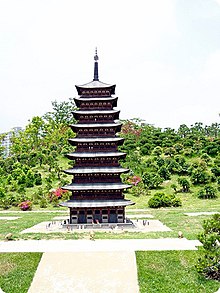Hwangnyongsa
| Hwangnyongsa | |

A miniature reconstruction of what the main pagoda may have once looked like.
|
|
| Korean name | |
|---|---|
| Hangul | 황룡사 |
| Hanja | |
| Revised Romanization | Hwangryongsa |
| McCune–Reischauer | Hwangryongsa |
Hwangnyongsa, or Hwangnyong Temple (also spelled Hwangryongsa) is the name of a former Buddhist temple in the city of Gyeongju, South Korea. Completed in the 7th century, the enormous 9-story structure was built entirely with wood with interlocking design with no iron nails. It had a standing total height of 80 m (262ft), making it the tallest structure in East Asia and the tallest wooden structure in the world at the time of its construction. It was the center of state-sponsored Buddhism during the Silla and Unified Silla eras which were cultural beacons of Buddhism during its time. Its name means "Golden/Yellow Dragon Temple" or "Emperor/Imperial Dragon Temple." Archaeological excavations and other scientific studies of the temple began in April 1976 (OCPRI 1984) and continue today.
Hwangnyongsa was built during the Silla period, under the patronage of the Silla royal family, on a plain encircled by mountains near the royal palace compound of Banwolseong (Half-Moon Palace). Construction began in 553 under the reign of King Jinheung, and was not fully completed until 644. King Jinheung originally intended for the temple to be the site of a new palace but when a dragon was seen on the proposed site, a temple was commissioned instead. Hwangnyongsa was designed to be a place where monks prayed for the welfare of the nation by asking for the divine protection of the Buddha and a means to impress foreign dignitaries.
Following the defeat of Baekje in the 660s, the Baekje architect, Abiji, was commissioned to build a nine-story wooden pagoda at the site. This fact indicates that the Baekje had superior knowledge of wooden architecture. The nine stories supposedly represented the nine nations of East Asia and Silla's future conquest of those states. The pagoda stood until it was burned by Mongolian invasions in 1238. No wooden architecture from the Silla people survives today but the ruins of Hwangnyongsa suggest a Goguryeo influence.
...
Wikipedia
